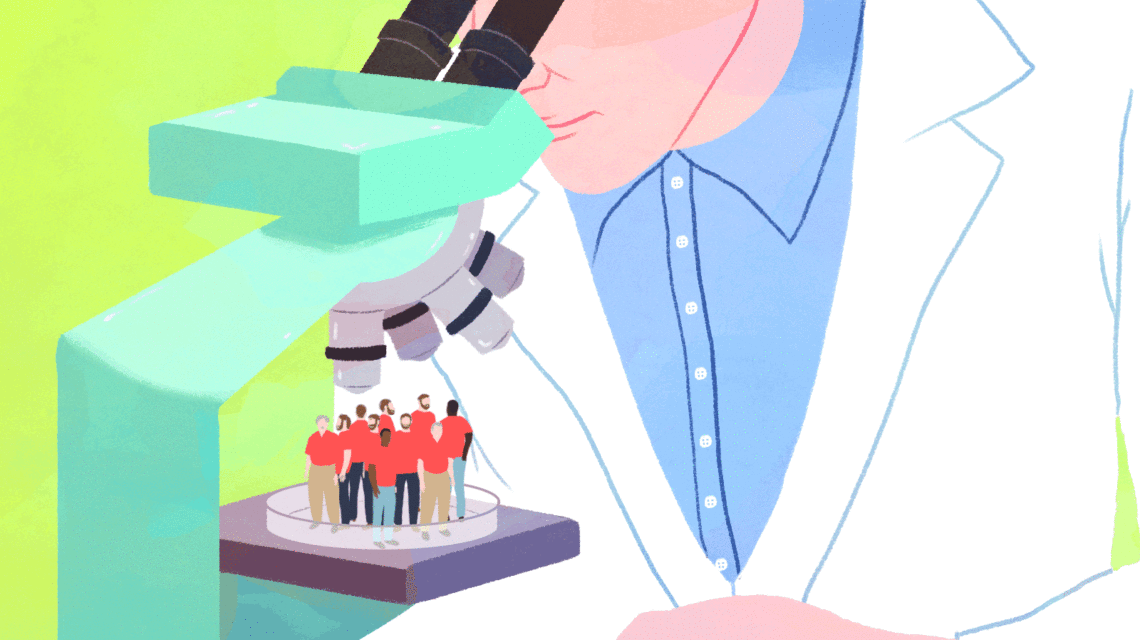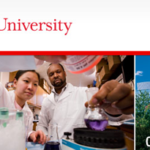By Yessenia Funes
Grist, February 15, 2018 —
The environmental sciences lack diversity — and that leaves holes in our understanding of health.

It’s been 20 years since Esteban González Burchard took a trip to Chicago that changed his life. The asthma researcher had been to the Windy City before, so tourism wasn’t on his agenda. Rather, he was there to attend the American Thoracic Society Conference for the first time. And he was on a mission.
The then-senior medical resident at Boston’s Brigham and Women’s Hospital had given himself a steep challenge: Read all the posters within his field, epidemiology. (Just so you know, there were hundreds of them.)
Amid the flood of research abstracts, images, and data, one graphic caught his eye. Colored in blue hues, a map from the Centers for Disease Control and Prevention depicted asthma prevalence among Latinos in the United States. A quick glance seemed to tell a simple tale: Latinos in New York, Massachusetts, and other northeastern states experienced asthma at significantly higher rates than Latinos living in other parts of the country.
Except Burchard realized this wasn’t the whole story. When he studied the poster more closely, he was able to connect it with his own work on a certain mutation to the interleukin-4 gene. He knew that a certain variant of the gene, which he’d linked to increased asthma severity, is more common in African-Americans, and that Puerto Ricans have a deeper African ancestry than other Latinos. So this asthma hotspot in the U.S. Northeast was a reflection, in part, of the heavy Puerto Rican population in that region.

Esteban Burchard in his lab at UCSF. Noah Berger / UCSF
“I was like, ‘I know what this is,’” Burchard tells Grist. “This is the African gene coming through Puerto Rican populations.”
The Mexican American scientist, now a professor and principal investigator at the University of California, San Francisco’s Asthma Collaboratory, grew up in California, home to the largest number of Latinos, most of whom are of Mexican origin. But he also spent time in Boston, where the Latino population is largely Puerto Rican. And he thought those regional differences might be behind the disparate asthma rates.
“It was because of my personal experiences that I was able to look at a scientific problem and nail it on the head in 30 seconds,” Burchard says.
Puerto Ricans have the highest asthma rate among Latinos in the United States, whereas Mexican Americans have the lowest (13.6 percent of the population versus 5.3 percent, respectively), according to more recent data from the CDC. With his revelation 20 years ago, Burchard helped birth the Genetics of Asthma in Latino Americans study, the largest survey of Latino children with asthma across the country. Through his work, he has collected DNA from more than 10,000 children of African American or Latino descent from around the country.
“No one was studying this prior to us,” Burchard says. “So the fact that I’m Latino, the fact that I’m interested in this, the fact that I’m trained in medicine and genetics, was a tremendous benefit to the field.”
But we may not be getting insights like the one Burchard had at the rate we could be. After all, there’s an overall lack of people of color in science. And that’s especially true of the environmental and climate sciences. An analysis of science employment patterns found the workforce in the medical and life sciences is the most diverse, while the makeup of environmental scientists and geologists is among the least diverse.
Adam Pearson, an associate professor of psychology at Pomona College in Southern California, performed that employment survey. He says the so-called “green STEM fields” are unique in their overrepresentation of white people compared with the other sciences. Even Asian Americans, who are well represented in other sciences, aren’t prevalent in them.
“In green STEM fields — broadly defined as conservation sciences, environmental sciences, climate-related sciences, earth, and atmosphere — you find up to twice the level of disparities, sometimes up to three times the level of disparities as you do in other physical sciences,” Pearson says. “That was really striking to us, and that’s across the board.”
Simply put, the environmental sciences have a diversity problem, and it’s not just costing us eureka moments like Burchard’s. After all, people of color are more likely to live in places with dirty air and are, thus, more often at risk from health problems linked to polluting industries and climate change. Yet they’re often getting overlooked.
According to Burchard’s own work, fewer than 5 percent of the respiratory disease research programs funded by the National Institute of Health between 1993 and 2013 involved studies that included non-white participants — even though they make up nearly 40 percent of the U.S. population. So in a subject area like asthma, there’s likely a dearth of data on groups where the illness is highly prevalent. That not only limits our understanding of the condition, but it could also impede the discovery of preventative measures and treatments.
So why are people of color underrepresented in the environmental sciences? It’s not for a lack of interest. Studies have found that Latinos, for example, tend to be more worried about climate change than people from other ethnic groups, according to a report the Yale Program on Climate Change Communication released in September (coincidentally right around the time Hurricane Maria struck Puerto Rico).
“These are groups that are, in fact, not only disproportionately affected by environmental problems but are also the most concerned — more concerned in most public opinion surveys than whites and higher-income groups,” says Pearson. “But the public doesn’t see it that way, so there’s a prominent archetype: the myth of the white environmentalist.”
This image of an older white person that the word “environmentalist” conjures has certainly played a part in determining who goes on to study environmental science. Pearson is one of many who are eager to find solutions to what he calls “the diversity crisis” among researchers. Another is Aradhna Tripati, who is out to smash outdated archetypes — and, ultimately, transform the field.
Tripati is an associate professor at the University of California, Los Angeles, whose work straddles the climate sciences and geology. Her research on the history of the Earth’s climate landed her on former President Barack Obama’s radar: Just prior to leaving office last year, he presented her with the Presidential Early Career Award for Scientists and Engineers. And with the help of this distinction, Tripati launched the UCLA Center for Diverse Leadership in Science in July, which focuses on the role of race in the environmental sciences.
“My thought was that we need to explicitly elevate this — diversity as a value,” Tripati tells Grist.

Aradhna Tripati holds a meeting in her UCLA lab. UCLA
Tripati herself had a unique path to the research lab. The daughter of Fijian immigrants, she grew up in a single-parent household for part of her childhood. For the past 25 years, her father has been incarcerated for his role in a fraud scheme. (Numerous witnesses who testified against him have subsequently recanted their testimony, Tripati says). Her mother, a nurse, was left to take care of Tripati and her younger sister. A once-decorated healthcare worker, she was briefly homeless after her husband was incarcerated.
And it’s her mom who Tripati credits with giving her the support and access to opportunities that helped her get from a childhood marked by isolation and bullying to where she is now: director of her own UCLA research center and lab. “She was also a person who, at other times, had nothing and, in fact, dealt with the consequences of systemic racism,” Tripati says of her mother. “That’s something that’s defined my family, my mom’s trajectory through life — as well as of course my dad’s — but my mom’s, my sister’s, my own.”
Paying her mom’s gift forward, Tripati is trying to pave a path for other people of color. This work isn’t anything new to her — diversity has been a founding principle in assembling the members of her research lab since 2013. She’s disturbed to see how often her minority students support their families while in school and how often they’ve had to deal with violence — from sexual assault to psychological violence that she says stems from racism.
Tripati’s center ensures practical measures are in place to help younger students in the community surrounding UCLA have the same opportunities as more privileged classmates. A key component of her new effort is drumming up financial support. Eventually, she hopes to offer scholarships and fellowships every year to 150 recipients interested in the sciences. These fellows could include high school students, undergrads, graduate students, researchers, faculty, and people working outside of academia. Fellows of the Center for Diverse Leadership in Science could be paired up with younger students from the community — for instance, helping high school kids learn how to conduct their own research.
Jesse Bloom Bateman is a postdoctoral researcher at UCLA’s Institute of the Environment and Sustainability. Like Tripati, he studies what the Earth’s climate was like thousands of years ago. He’s also a volunteer for the center, working with young, diverse students in Los Angeles.
“As a black man in geology — where that is fairly unique — I can see how having a diverse group of people with diverse backgrounds helps us get to more interesting answers and also ask deeper and broader questions,” Bateman tells Grist.
Tripati’s hope is that her fellows can become leaders who recruit a new generation of scientists from underrepresented groups. They and future researchers can then design and execute better studies that can help untangle major structural problems that disproportionately affect diverse populations.
“Communities of color in the U.S. face higher rates of asthma, lead poisoning, environmental harm, and are the least likely to get the relief services they need to survive during natural disasters like Hurricanes Maria, Katrina, and Harvey,” Tripati says. “Having representation changes the nature of the priorities that get made, the questions we ask, and the solutions that are proposed.”
As the Trump administration rolls back environmental protections and gives more power to fossil fuel corporations, there are fears that air pollution and other toxic exposures will rise in the near future. Vulnerable, low-income communities and people of color are most often the populations surrounding hazardous waste sites, petrochemical plants, and highly trafficked roadways. This proximity to pollution coupled with genetic predisposition is a recipe for poor health.
According to Esteban Burchard’s colleague Sam Oh, director of epidemiology at the Asthma Collaboratory, diverse scientists have an advantage in working with communities that aren’t often part of research efforts. “If [scientists] share your culture, if they look like you,” Oh says, “you’re going to be more likely to identify with them and be more receptive.”
Looking at a subject like asthma, having ethnic variation in research subjects can help scientists tease out various triggers that lead to the development a disease. For example, studies that don’t include Puerto Ricans and black people — two groups that suffer some of the highest rates in the U.S. — won’t be as effective in pinpointing patterns about the prevalence in those populations or even in the country overall.

A highway overlooks an elementary school playground in Denver. Kathryn Scott Osler / Contributor / Getty Images
“In many diseases — not just asthma — there are differences in genetic risk factors that vary across race,” Oh tells Grist. “Just because you have that risk factor doesn’t mean you’re going to automatically develop the disease. There are a lot of pieces to this puzzle, and once all those pieces are put in, then a person develops disease.”
In 2013, a large research team, including Burchard and Oh published a study that examined the asthma risk among black and Latino children exposed to air pollution in cities across the U.S. In San Francisco, in particular, the results were stark across racial lines: Air pollution seemed to impact asthma rates in black children more so than their Mexican-American neighbors.
Late last year, the American Petroleum Institute seized on the results of studies that have found similar differences in asthma rates among minorities. It used that data to rebuff an NAACP report about skyrocketing asthma rates among black communities living near oil and gas operations. Among other potential causes, such as indoor allergens, they pointed to a body of research that found a genetic predisposition for developing the debilitating respiratory illness among African Americans.
Burchard says the argument was Big Oil attempting to “wash its hands” of a problem it contributed to. As for Oh, he doesn’t attribute the pattern of differences in asthma incidence found in the 2013 study directly to ethnicity — where these groups tended to live could also influence whether they’ll develop asthma. As any scientist worth his salt would say — and Oh did — no single factor leads a person to develop asthma, including ancestry. Plus, there’s more data to be collected, especially from minority communities, that could change the way we treat asthma.
“As long as we understand the biology of disease better — and that comes from studying more diverse populations — we can develop better therapies that can be applied to all people,” Oh says.
This isn’t a chicken-and-egg problem, if you ask people like Burchard or Aradhna Tripati. The impetus for studying new or previously overlooked populations will most likely come from bringing members of those groups into the scientific community in higher numbers. And that could mean more aha! moments that will benefit us all.
Burchard sums up the issue succinctly: “Increased diversity in science and medicine leads to better science.”











